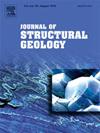南非Karoo盆地Whitehill组二叠系富有机质页岩裂缝网络定量表征及其对油气勘探、二氧化碳封存和其他裂缝性地流体系统的启示
IF 2.9
2区 地球科学
Q2 GEOSCIENCES, MULTIDISCIPLINARY
引用次数: 0
摘要
泥岩地层(页岩)越来越被认为是油气勘探和生产的目标,是二氧化碳储存的场所,也是核废料和其他废物的储存库。由于页岩的基质渗透率较低,大量的流体流动可能发生在裂缝内,因此在裂缝网络的表征上投入了大量的精力。本文报道了对南非Karoo盆地Whitehill组二叠系富有机质页岩裂缝网络的多学科野外和钻孔研究结果,该页岩发育于下侏罗统白云岩侵入岩附近。目标是系统地记录不同的裂缝类型,区分潜在的压裂机制,并量化它们对侵入相关富有机质页岩裂缝网络的贡献。我们的观测包括基于地面和无人机摄影测量的高分辨率数字露头模型,以及来自裂缝胶结物和其中的流体包裹体的岩石学和地球化学数据。研究结果表明,所研究页岩中的裂缝网络是由一系列与断层侵入有关的过程形成的。这导致了五种不同的裂缝类型的形成,它们具有不同的方向和裂缝填充材料:(1)垂直固体沥青脉;(ii)亚垂直至水平的固体沥青方解石脉;(iii)紧密分布的亚垂直方解石脉;(iv)水平沥青和方解石脉;(五)次垂直节理。根据裂缝类型的空间分布,划分出3个裂缝域:上、中、下域,上、下域离侵入体较近,中心域离侵入体较远。上下域以固体沥青和固体沥青-方解石脉为主,垂直方向强,呈北向南走向。而中部地区则由近水平的固体沥青方解石脉组成。上、下域的垂向张性裂缝可能是由于侵入性加热引起的烃类运移和其他热液流体引起的孔隙流体压力升高而形成的。中部地区的水平张性裂缝可能与富有机质页岩的热成熟和孔弹性变形有关。南北向张性断裂的发育与早侏罗世东西向伸展构造导致冈瓦纳断裂的正断层相一致。利用数字裂缝网络量化方法,评价了Karoo页岩垂直和水平张性裂缝类型对裂缝方位、强度和连通性空间变化的相对贡献。所有观察到的裂缝类型都有助于油气和流体的运移和储存。我们的观察表明,含有天然裂缝集的露头可以用来表征裂缝的关键属性,如裂缝长度、空间排列、连通性以及不同压裂机制对受火成岩侵入影响的富有机质页岩流体流动和储存的贡献。本文章由计算机程序翻译,如有差异,请以英文原文为准。
Quantitative characterization of fracture networks in the Permian organic-rich shales of the Whitehill formation in the Karoo Basin, South Africa and implication for hydrocarbon exploration, CO2 sequestration, and other fractured geofluid systems
Mudstone formations (shales) are increasingly recognized as targets of hydrocarbon exploration and production, sites for CO2 storage, and repositories for nuclear and other waste. Due to their low matrix permeability, considerable amount of fluid flow in shales may occur within fractures, and consequently significant effort is placed on the characterization of fracture networks. We report results of a multidisciplinary field and borehole study of a fracture network in Permian organic-rich shales of the Whitehill Formation in the Karoo Basin, South Africa, developed in proximity to Lower Jurassic dolerite intrusive sills. The goal was to systematically document the different fracture types, differentiate the underlying fracturing mechanisms, and quantify their contribution to fracture networks in intrusion-related organic-rich shales. Our observations comprise high-resolution digital outcrop models constructed from ground- and drone-based photogrammetry, and petrographic and geochemical data from fracture cements and fluid inclusions contained in them.
Our results indicate that the fracture network in the studied shale developed from a suite of processes related to intrusion of the sills. These resulted in the formation of five distinctive fracture types, with varying orientation and fracture-filling material: (i) vertical solid bitumen veins; (ii) sub-vertical to horizontal solid bitumen-calcite veins; (iii) closely-spaced subvertical calcite veins; (iv) horizontal bitumen and calcite veins; and (v) sub-vertical joints. Based on the spatial distribution of these fracture types, three fracture domains are identified: upper, central, and lower domains, where the upper and lower domains are near the intrusions and the central domain at a greater distance.
The upper and lower domains are dominated by solid bitumen and solid bitumen-calcite veins that exhibit a strong vertical orientation with a N-S strike. In contrast, the central domain comprises nearly horizontal solid bitumen-calcite veins. The vertical tensile fractures in the upper and lower domains likely developed in response to increased pore fluid pressure associated with the mobilization hydrocarbon and other hydrothermal fluids caused by intrusive heating. The horizontal tensile fractures in the central domain may be related to the thermal maturation and poroelastic deformation of the organic-rich shales. The development of the N-S tensile fractures is consistent with the normal fault regime associated with the E-W Early Jurassic extensive tectonics that led to the breakup of Gondwana.
The relative contributions of the vertical and horizontal tensile fracture types in the Karoo shale to spatial variation of fracture orientation, intensity, and connectivity were evaluated using digital fracture network quantification. All observed fracture types contributed to hydrocarbon and fluid migration and storage. Our observations demonstrate that outcrops containing natural fracture sets can be used to characterize crucial fracture attributes such as fracture length, spatial arrangement, and connectivity and contribution of different fracturing mechanisms to fluid flow and storage in organic-rich shales impacted by igneous intrusions.
求助全文
通过发布文献求助,成功后即可免费获取论文全文。
去求助
来源期刊

Journal of Structural Geology
地学-地球科学综合
CiteScore
6.00
自引率
19.40%
发文量
192
审稿时长
15.7 weeks
期刊介绍:
The Journal of Structural Geology publishes process-oriented investigations about structural geology using appropriate combinations of analog and digital field data, seismic reflection data, satellite-derived data, geometric analysis, kinematic analysis, laboratory experiments, computer visualizations, and analogue or numerical modelling on all scales. Contributions are encouraged to draw perspectives from rheology, rock mechanics, geophysics,metamorphism, sedimentology, petroleum geology, economic geology, geodynamics, planetary geology, tectonics and neotectonics to provide a more powerful understanding of deformation processes and systems. Given the visual nature of the discipline, supplementary materials that portray the data and analysis in 3-D or quasi 3-D manners, including the use of videos, and/or graphical abstracts can significantly strengthen the impact of contributions.
 求助内容:
求助内容: 应助结果提醒方式:
应助结果提醒方式:


